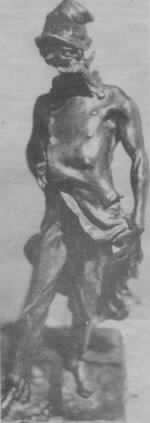 "La
Vie Moderne"
"La
Vie Moderne"19th Century Kitsch at UCSB
(Originally Published in the Santa Barbara News and Review, 4/29/77)
 "La
Vie Moderne"
"La
Vie Moderne"
19th Century Kitsch at UCSB
(Originally Published in the Santa Barbara News and
Review, 4/29/77)
By Dan Gheno
The new exhibition at the University Art Galleries, "The Cult of images ó Baudelaire and the 19th Century Media Explosion," comprises the best of supposedly "bad art." Beatrice Farwell, with the help of her graduate students, has organized a selection of last century's mass-media "schlock" to demonstrate its effect on fine art, which is also represented by some prints by Manet and Degas.
During the 19th century, as printing techniques improved and as the French lower middle class became more literate, cheaply illustrated newspapers, family journals, sexy pin-ups and "quickie" novels flourished. These publications were down to earth, only concerned by the needs, experiences and emotions of their immediate times.
This thirst for "modernity (la vie moderne)," as Baudelaire termed it, was too irreverent and unpoetic for the bourgeoisie. However, they were eventually overwhelmed by the sheer proliferation of the press. As Baudelaire said, "There is in ordinary life.., rapid movement that demands an equal speed of execution on the part of the artist."
While many mass-media artists were hiring inefficient assistants to lighten their load, political cartoonist Honore Daumier (who lived next door to Baudelaire) seemed to accommodate the intense schedule by pruning all the frills from his lined work until he finally achieved a concise clarity of style that gave demanding conviction to his message.
In the exhibition, Daumier is only represented., by one of his many sculptures of corrupt politicians. His statues were not unlike his cartoons, and in fact, he often used them for drawing reference.
Daumierís work influenced many of his high art contemporaries, including Degas. Degas collected and made studies from his newspaper work, dissecting and imitating his impulsive line work and his razor-sharp dark-and-light contrasts. Thanks to Daumier and also to a less subtle cartoonist, Charles Phillipon, Degas said he learned the value of simplicity and saw that the essence of caricature "boiled down to an easily remembered formula."
Too bad the other mass media artists paid little heed to this formula. As I entered the gallery, I was struck by the uniform grayness of the show. Each piece is so over garnished that I found little white space (other than the wall) for relief or contrast.
Of course, at the time, the public ó especially the male public ó found these often erotic, raucous drawings a vicarious "relief" from Victorian mores. Less seductive pictures, like those depicting circuses, picnics and war, also gave the "common public" a form of escapism which, while based in reality, had enough romanticism to elevate them from urban monotony.
The aristocracy never did accept social realism, Although they were ready to accept pictures depicting brothels, matrimonial slavery and homosexuality in Biblical and historical contexts, they felt threatened when they were faced with the same subject matter in a contemporary setting.
Manet was one of the first fine art painters to rock the boat, when he exhibited his masterpiece, "Olympia," in the Salon. The painting, of a woman stretched across a bed in full, frontal nudity, was not condescending and did not sexually objectify females. The painting owes a great deal to the old masters, but at the same time it also did look compositionally similar to the many inexpensive, erotic photos which were popular among the lower class. In fact, the painting barely deviates from the design of one the anonymous mass media photos presented in the exhibition.
When Napoleon 111 declared another one of Manetís paintings indecent, I suspect that he was probably not expressing moral indignation as much as he was trying to punish and stem the tide of individuality and independence that the artist was exerting.
More and more, artists painted for themselves, and as in Manetís "Balloon," "The Race," and even in their mass media work, the artists were putting less emphasis on the subject matter than on the wild, jabbing strokes that made up their images. In essence, Manetís prints show that the subject matter is not the balloon or the horses but is actually the active processes which were involved in the production of the images.
In Degasí two mono-prints of women at their toilet, you can easily imagine the artist at work, as he formed his image in a give and take process. Perhaps, he added a detail here and subtracted a detail there until the unpredictable picture --in its own time-- resolved itself to his satisfaction.
Although this method offers the greatest opportunities for unique solutions to old artistic problems, the exhibition shows that more mass media artists would rather stick with safe and uninteresting solutions than risk violation of the deadline through impromptu experimentation.
To the commercial hack, the "finished product" is all. Degas, on the other hand, never considered a canvas or drawing complete, and on many occasions, he had to be forcibly restrained from adding new finishing touches to oils that had been framed and displayed for years.
Daumier had so little respect for the "finished product" that he cavalierly flung all of his pencil sketches onto one stack, where the combined weight and friction of the paper eventually erased many of his images over the years.
Today, Daumierís indifference would be called an art happening, and surely some good commercially-oriented gallery would find a way to capitalize upon it as they do with many of the present-day pseudo-artists who shoot off bits of their skin, roll in mud and masturbate in public.
Itís scary: schlock has returned, but now the fine art cult is more to blame than the mass media.
| REVIEW #7 | REVIEW #8 | REVIEW #9 | REVIEW # 10 | |
| REVIEW #12 | REVIEW #13 | REVIEW #14 | REVIEW #15 | |